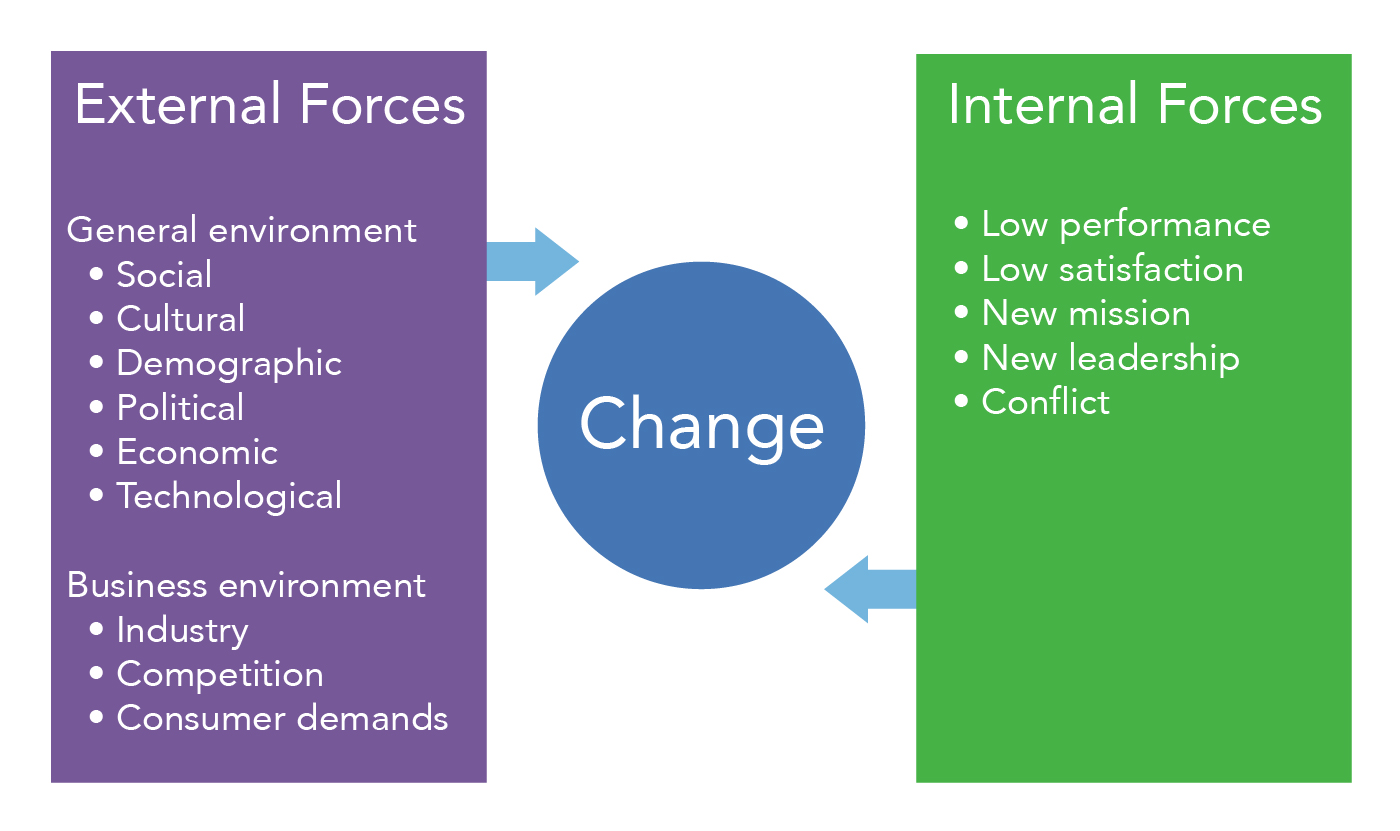15.7: Forces of Change
- Page ID
- 48780
Learning Objectives
- Describe forces of change
The art of progress is to preserve order amid change and to preserve change amid order.
—Alfred North Whitehead
Alfred North Whitehead was a philosopher and mathematician, but, with that kind of insight on the subject of change, he could have been a CEO. Today’s business leaders have to worry about addressing customer needs in a fast-paced environment impacted by social, economic, political and cultural shifts. In today’s business environment, the ever-looming presence of change is pretty much the only thing that stays the same.
The problem is, no one likes change.

Organizations and their managers have to learn how to anticipate and implement change effectively. Managers need to find ways to overcome their employees’ natural aversion to change, because managing change effectively can mean the difference between staying in business and becoming irrelevant to their customers. The first step in managing change effectively is to understand what change is and where it comes from.
Organizational change is the transformation or adjustment to the way an organization functions. Organizations adjust to small changes all the time, possibly looking to improve productivity, responding to a new regulation, hiring a new employee, or something similar. But on top of these little adjustments we make at work all the time, there are larger pressures that loom over us, like competition, technology, or customer demands. Those larger pressures sometimes require larger responses.
What forces create these changes?
External forces are those changes that are part of an organization’s general and business environment. There are several kinds of external forces an organization might face:
- Demographic. A changing work demographic might require an organizational change in culture. For instance, Avon built and grew their business around door-to-door cosmetic sales, with the stay-at-home wife and mother as their primary front line employee. When more women entered the workforce in 9-to-5 jobs, Avon had to shift gears and find new ways to get their products in front of their customers.
- Social. Changing social trends can pressure organizations into making changes. Consumers are becoming more environmentally conscious, a trend which has pushed fast food restaurants to replace Styrofoam containers with paper. Manufacturers of cleaning products changed product formulas to omit phosphorus and other environmentally threatening chemicals. Tobacco companies have buckled under the changing image of smokers, the dangers of their products, and some have started looking into eCigarettes and other smoking alternatives to stay in business.
- Political. Government restrictions often force change onto organizations. This can be something as simple as a change in minimum wage for employees, or as complex as rules and restrictions governing fair competition in business. For instance, when the Affordable Health Care act was put into place, businesses had to change their operations and put steps into place to confirm that all employees had healthcare coverage to comply with the new law.
- Technology. Still have your VHS player? The founder of Blockbuster wishes you did. Technological changes can make or break a business. Whether new technology is introduced industry-wide, as when the laser was introduced to modern medicine, making surgeries easier and safer; or when it’s introduced to end users, as when consumers stopped renting videos to enjoy the cheaper, more convenient streaming services like Netflix, organizations must change to accommodate new technologies or suffer the consequences.
- Economic. During the 2008 recession, consumers lost their jobs and cut back on their spending. These economic downturns had a major impact on businesses. Banks failed. General Motors and Chrysler filed for bankruptcy. Survival meant adapting to change. Companies like Lego, who experienced stagnant U.S. sales during this time, took the opportunity to build their markets in Europe and Asia. Netflix realized the potential of providing in-home entertainment to families that had cut back their entertainment budgets and grew their subscriptions by 3 million subscribers in 2009 alone. Meanwhile, in the midst of spiking fuel prices, gas guzzling Hummers were no longer en vogue and quietly went out of business.
Companies can also experience internal forces of change, which can often be related to external forces, but are significant enough to be considered separately. Internal forces of change arise from inside the organization and relate to the internal functioning of the organization. They might include low performance, low satisfaction, conflict, or the introduction of a new mission, new leadership.

Figure \(\PageIndex{1}\): Internal and external forces of change. External forces include the general environment and the business environment. General environmental forces include social, cultural, demographic, political, economic, and technological. Business environment forces include industry, competition, and consumer demands. Internal forces of change include low performance, low satisfaction, new mission, new leadership, and conflict.
Practice Question
Low performance within an organization must obviously be addressed with change that facilitates higher performance. When low performance yields low quality or inefficiencies, customers complain and organizations need to change.
Harley-Davison’s Beginnings[1]
Perhaps one of the most famous examples of a company that overcame this situation is Harley-Davison. In 1980, no one wanted a Harley. They were a poor quality bike that even leaked oil on the showroom floor. Their parent company, AMF, couldn’t find a buyer for them, and thirteen Harley managers ended up buying the company.
Dramatic changes were needed, and the new CEO approached them with top-down authority. First, they laid off 40% of the workforce—salaried and hourly alike—and the remaining employees took a 9% pay cut. Their design team built the Evolution Engine and, coupled with the sleek design of their new Softail product line, sales started to improve. Perhaps most significantly, they developed the HOG (the Harley Owners Group) as a way to communicate with their customers. Operating improvements were made, and dealers started looking at Harley as a dependable partner. When they went public in 1986, underwriters were shocked that their IPO raised $25 million more than expected.
Facebook’s Mission Statement[2]
Companies often respond to external forces by taking on new missions and new leaders. Facebook’s original mission statement was “Making the world more open and connected.” CEO Mark Zuckerberg spent much of 2017 coming under fire for scandals (including accusations of data breaches and the potential of Facebook influencing the 2016 US election).
As the world continued to divide, he led the company in unveiling a new mission statement. That statement, “Give people the power to build community and bring the world closer together,” was accompanied by the release of new group management tools within the application and a goal to help a billion people join new communities. Zuckerberg also acknowledged that Facebook is no longer a simple platform that connects friends and families, but instead a powerhouse that can have significant influence on individuals and how they interact with the world.
Lowe’s new CEO[3]
When a company brings on a new CEO, that’s often an internal force for change. In July of 2018, Home Depot veteran Marvin Ellison became the CEO of the faltering Lowe’s, a competing big box home improvement retailer. In his first months as CEO, he set out to improve store productivity and customer service in the stores, closed a division of smaller Lowe’s stores and eliminated $500 million in capital projects to free up cash to return to shareholders. He also let go the company’s Chief Financial Officer and Chief Operations Officer. No doubt, the company was reeling over the changes, but it might prove just what they need to get back on track. Time will tell.
More often than not, these forces of change are outside of an organization’s control, but, without exception, they all must be managed if an organization is going to be successful. In the next section, we’ll take these forces of change and dissect them a little bit more, so we can get a better understanding of how we can successfully manage them.
- Teerlink, Rich. "Harley's Leadership U-Turn." Harvard Business Review. July/August 2000. Accessed April 26, 2019. https://hbr.org/2000/07/harleys-leadership-u-turn. ↵
- Statt, Nick. "Mark Zuckerberg Just Unveiled Facebook's New Mission Statement." The Verge. June 22, 2017. Accessed April 26, 2019. https://www.theverge.com/2017/6/22/15855202/facebook-ceo-mark-zuckerberg-new-mission-statement-groups. ↵
- Townsend, Matthew. "Lowe's CEO Takes Medicine Now to Get Retailer on Firmer Footing." Bloomberg. August 22, 2018. Accessed April 26, 2019. https://www.bloomberg.com/news/articles/2018-08-22/lowe-s-ceo-takes-medicine-now-to-get-retailer-on-firmer-footing. ↵
Contributors and Attributions
- Forces of Change. Authored by: Freedom Learning Group. Provided by: Lumen Learning. License: CC BY: Attribution
- Image: Forces of Change. Provided by: Lumen Learning. License: CC BY: Attribution
- Time Clock Movement. Authored by: Free-Photos. Provided by: Pixabay. Located at: pixabay.com/photos/time-clock-movement-motion-1246003/. License: CC0: No Rights Reserved. License Terms: Pixabay License

